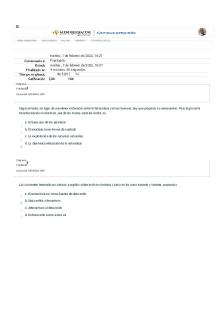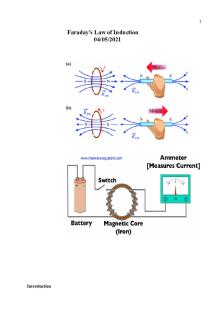Control Lab 6 PDF

| Title | Control Lab 6 |
|---|---|
| Author | Shahzaib Qadir |
| Course | Control Systems |
| Institution | COMSATS University Islamabad |
| Pages | 12 |
| File Size | 664.2 KB |
| File Type | |
| Total Downloads | 662 |
| Total Views | 978 |
Summary
Shahzaib Qadir FA18-EPE-Osama Idress FA18-EPE-Shahid Akhtar FA18-EPE-Class Control Systems Lab.Section CTeacher’s Name Dr. Uzair khanLab Engineer’s Name Muhammad Asad Javaid KhanDEPARTMENT OF ELECTRICAL ENGINEERINGCOMSATS UNIVERSTY ISLAMABD (ABBOTTABAD CAMPUS)Lab:06 Transient analysis of first order...
Description
Shahzaib Qadir
FA18-EPE-087
Osama Idress
FA18-EPE-117
Shahid Akhtar
FA18-EPE-100
Class
Control Systems Lab.
Section
C
Teacher’s Name
Dr. Uzair khan
Lab Engineer’s Name
Muhammad Asad Javaid Khan
DEPARTMENT OF ELECTRICAL ENGINEERING COMSATS UNIVERSTY ISLAMABD (ABBOTTABAD CAMPUS)
Lab:06 Transient analysis of first order systems Objective: The following lab would help the students to get familiar with first order systems and also with specifications of the first order systems.
Task 1 Find the pole location, rise time and settling time of the following PART A A)
G ( s )=
1 S+ 1
CODE a=1; ta=1/a; t=0:0.01:5*ta; x=(1-exp(-t)).*unit(t); plot(t,x); grid on; xlabel('Time'); ylabel('C(t)'); title('Transiant Analysis'); n=[1]; dn=[1 1]; figure; zplane(n,dn) title ('Pole Zero') figure; sys=tf(n,dn); pole(sys) grid on pzmap(n,dn) figure; step(sys) grid on stepinfo(sys) grid on
FIGURES:
Figure 1. Transiant Analysis of G ( s )=
1 S+1
Figure 2. Pole Zero graph of G ( s )=
1 S+ 1
Figure 3. Step response of
G ( s )=
1 S+1
---------------------------------------------------------------------------
PART B B)
G ( s )=
5 s+ 2
CODE a=2; ta=1/a; t=0:0.01:5*ta; x=((5/2)-(2/5)*exp(-2*t)).*unit(t); plot(t,x); grid on; xlabel('Time'); ylabel('C(t)'); title('Transiant Analysis'); n=[5]; dn=[1 2]; figure; zplane(n,dn) grid on title ('Pole Zero') figure; sys=tf(n,dn); pole(sys)
grid on pzmap(n,dn) figure step(sys) grid on stepinfo(sys) grid on
FIGURES:
Figure 4. Transiant Analysis of G ( s )=
5 S+2
Figure 5. Pole Zero graph of G ( s )=
Figure 6. Step response of G ( s )= RiseTime SettlingTime SettlingMin SettlingMax Overshoot Undershoot Peak PeakTime
: : : : : : : :
5 S+2
5 S+2
1.0985 1.9560 2.2613 2.4999 0 0 2.4999 5.2729
TABLE: Pole Location -1 -2
Rise time calculated 2.2 1.1
Rise time observed 2.190 1.098 Table No:1
CONCLUSION:
Setting time calculated 4 2
Setting time observed 3.912 1.956
When pole move towards the left side Rise Time and Setting time will decreases. When rise time decreases the speed of system increases which means system will be fast and it settling time is less which means it will required less time to become stable. -----------------------------------------------------------------------------------------------------------------------
Task 2 For the RC circuit given below, find equation for output voltage, pole location, rise time and settling time when the applied voltage is �� (�) = step voltage, For the circuit 50٠and C =5Mf.
SOLUTION: To Find the equation we have to apply the VDR
EQUATIONS:
CODE: n=[1]; dn=[0.25 1]; zplane(n,dn) figure title('Pole zero'); sys=tf(n,dn) pole(sys) pzmap(n,dn); grid on figure step(sys); grid on figure stepinfo(sys); grid on figure
FIGURES:
Figure 1. Pole zero graph of the RC circuit
Figure 1. Step Response graph of the RC circuit
TABLE: Pole location Rise time calculated Rise time observed Setting time calculated Setting time observed
-4 0.55 0.549 1 0.978 Table No:2
----------------------------------------------------------------------------------------------------------------------------
Task 3
A motor is an electromechanical component that yields an angular displacement output, θm , for an input voltage, e a , that is, a mechanical output generated by an electrical input. The motor’s schematic is shown in Figure 6.4(a) and its transfer function for motor speed response is shown in Figure 6.4(b).
The transfer function will be;
EQUATION:
Case 1 When K=1 and alpha varies from 1-5
CODE: for alpha = 1:5 k=1; s=tf('s'); G=k/(s+alpha); step(G) grid on hold on end
FIGURE:
Figure 1. Step response of electrical system connected with motor for Case 1
Case 2: When K=5 and alpha varies from 1-5
CODE: for alpha = 1:5 k=5; s=tf('s'); G=k/(s+alpha); step(G) grid on hold on end
FIGURE:
Figure 1. Step response of electrical system connected with motor for Case 2
CONCLUSION:
When pole move towards the right side Rise Time and Setting time will increases. When rise time increases the speed of system decreases which means system will be slow and its settling time is more so it will requires more time to become stable. On the other hand when pole move towards the left side shown in Rise Time and Setting time will decrease. When rise time decreases the speed of system increases which means system will be fast and it settling time is less so it will require less time to become stable. K effect the stability value of the system.
THE END...
Similar Free PDFs

Control Lab 6
- 12 Pages

Lab 6 Control of Microbe Growth
- 3 Pages

Control Lab
- 26 Pages

Lab 6 - Lab 6
- 10 Pages

Control de lectura 6
- 2 Pages

Jorge Carvajal Control 6
- 7 Pages

Level Control lab report
- 9 Pages

Lab 6 - Lab Report
- 6 Pages

LAb 6 - Lab
- 1 Pages

Lab 6 Nitration LAB
- 5 Pages

Lab 6 - lab answer
- 6 Pages

Lab 6 Chem 112 - Lab 6
- 2 Pages

Phys lab 6 - Lab report 6
- 13 Pages

Lab Report Nr 6 - lab 6
- 7 Pages

Unit 6 lab - Unit 6 lab
- 1 Pages

Actividad 6 - Direccion Y Control
- 11 Pages
Popular Institutions
- Tinajero National High School - Annex
- Politeknik Caltex Riau
- Yokohama City University
- SGT University
- University of Al-Qadisiyah
- Divine Word College of Vigan
- Techniek College Rotterdam
- Universidade de Santiago
- Universiti Teknologi MARA Cawangan Johor Kampus Pasir Gudang
- Poltekkes Kemenkes Yogyakarta
- Baguio City National High School
- Colegio san marcos
- preparatoria uno
- Centro de Bachillerato Tecnológico Industrial y de Servicios No. 107
- Dalian Maritime University
- Quang Trung Secondary School
- Colegio Tecnológico en Informática
- Corporación Regional de Educación Superior
- Grupo CEDVA
- Dar Al Uloom University
- Centro de Estudios Preuniversitarios de la Universidad Nacional de Ingeniería
- 上智大学
- Aakash International School, Nuna Majara
- San Felipe Neri Catholic School
- Kang Chiao International School - New Taipei City
- Misamis Occidental National High School
- Institución Educativa Escuela Normal Juan Ladrilleros
- Kolehiyo ng Pantukan
- Batanes State College
- Instituto Continental
- Sekolah Menengah Kejuruan Kesehatan Kaltara (Tarakan)
- Colegio de La Inmaculada Concepcion - Cebu